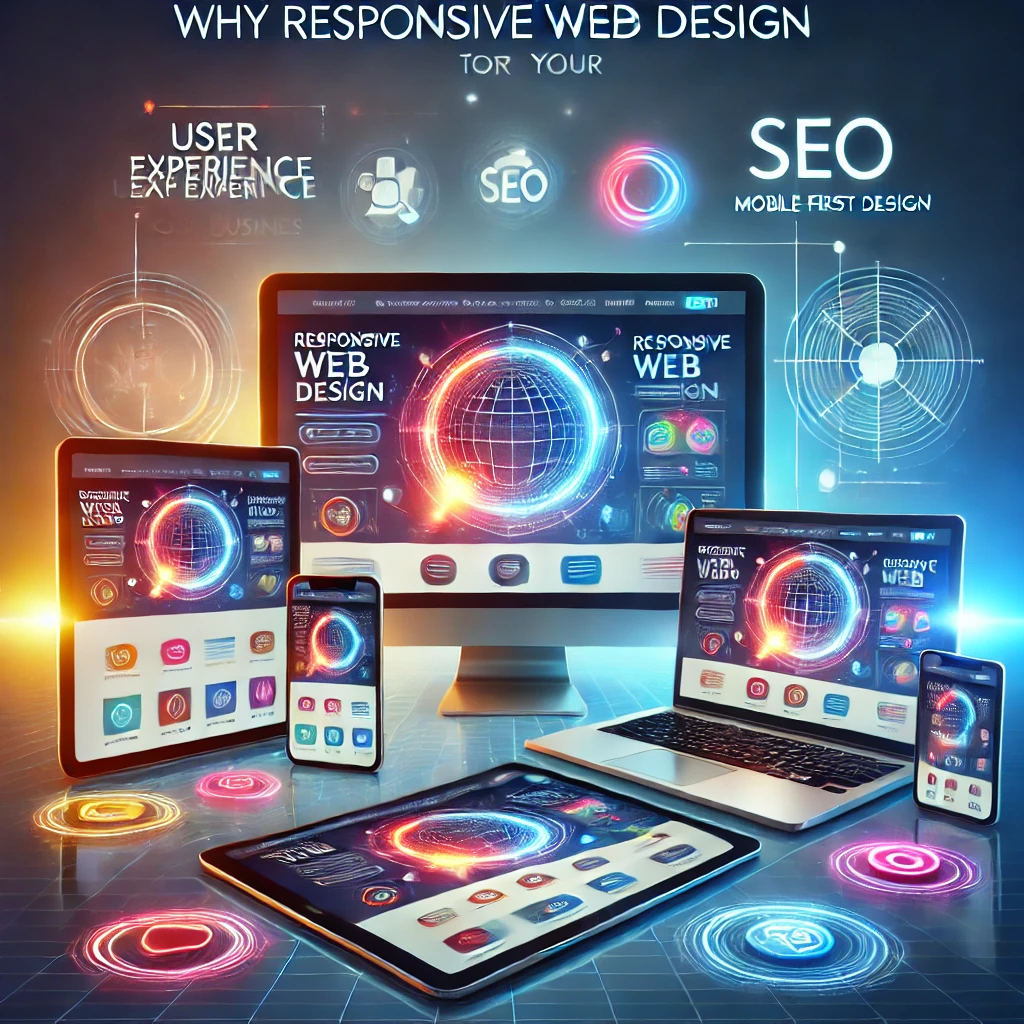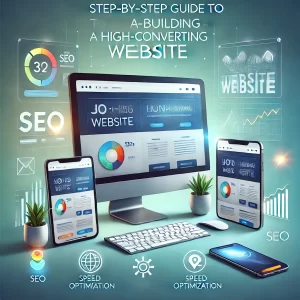
In a world where digital interactions dominate, having a website is a must. But more than just having an online presence, the quality of your website experience matters. With over 55% of web traffic now coming from mobile devices, it’s crucial that your website is designed to provide a seamless user experience on all devices.
This is where responsive web design comes in. It’s the gold standard for creating websites that adapt and perform well, no matter the screen size. Let’s explore why responsive web design is critical for your business’s growth, customer satisfaction, and long-term success.
What is Responsive Web Design?
Responsive web design is a design approach that ensures your website adapts to any screen size—whether it’s a smartphone, tablet, laptop, or desktop computer. Unlike older methods, which required creating separate mobile and desktop versions of a site, responsive design dynamically adjusts layouts, images, and text to deliver an optimal experience for each device.
Key Features of Responsive Web Design:
- Fluid Grids: Content scales proportionally based on screen size.
- Flexible Images: Visuals adjust their size while maintaining quality.
- Media Queries: CSS rules detect the user’s screen size and apply appropriate styles.
1. Enhanced User Experience (UX)
Why It Matters:
User experience is one of the most critical factors for your website’s success. Visitors are quick to leave a site that doesn’t load properly or is hard to navigate. Responsive web design ensures that every visitor has a smooth and enjoyable experience, regardless of the device they use.
What Users Want:
- Ease of Navigation: Simple menus and touch-friendly buttons.
- Readability: Text and images that fit their screen without zooming.
- Fast Loading Times: Websites optimized for mobile often load faster.
Real-World Example:
Imagine you own an online clothing store. A customer browsing on their phone struggles to view product details because the images don’t resize properly. Frustrated, they abandon your site and buy from a competitor with a mobile-friendly store. Responsive web design prevents this scenario, keeping users engaged and converting leads into sales.
2. SEO Benefits: Higher Rankings on Google
Google has shifted to a mobile-first indexing policy, meaning it evaluates your website’s mobile version before the desktop version. If your site isn’t mobile-friendly, you risk losing your ranking on search engine results pages (SERPs).
Key SEO Advantages of Responsive Design:
- Single URL Structure: Having one site for all devices strengthens your SEO strategy.
- Lower Bounce Rates: Visitors stay longer when the site is easy to use.
- Improved Page Speed: Faster load times are a ranking factor for Google.
Real-World Example:
Let’s say you run a blog. If your site isn’t responsive, mobile users who encounter poor formatting or slow load times will leave, increasing your bounce rate. This signals Google that your site isn’t user-friendly, negatively impacting your rankings.
Pro Tip: Use tools like Google’s Mobile-Friendly Test to check your site’s performance.
3. Cost-Effective Development
In the past, businesses needed two separate websites: one for desktop and one for mobile. Responsive web design eliminates this need, saving time and money.
Why It’s Cost-Effective:
- One Website, Multiple Devices: Maintain a single site that adapts to all screen sizes.
- Streamlined Updates: Changes made to one site automatically apply across devices.
- Reduced Maintenance Costs: A unified design is easier to manage.
Example:
A local bakery that uses responsive web design only needs to upload their menu once, and it looks perfect on both desktop and mobile. Without responsive design, they’d need two separate sites and double the work.
4. Boosts Conversion Rates
A seamless browsing experience translates into more conversions. Whether it’s making a purchase, signing up for a newsletter, or contacting you, responsive web design removes barriers that could deter users.
How Responsive Design Increases Conversions:
- Optimized CTAs: Buttons and forms are easier to interact with on mobile.
- Fewer Interruptions: Users can navigate smoothly without resizing or scrolling excessively.
- Consistency Across Devices: Users who begin their journey on one device can seamlessly continue on another.
Example:
An e-commerce website with responsive design can make the checkout process simpler on mobile, resulting in fewer abandoned carts and higher sales.
Pro Tip:
Test your calls-to-action (CTAs) on multiple devices to ensure they’re visible and easy to click.
5. Adaptability to Future Technology
The number of devices and screen sizes continues to grow. Responsive web design ensures your website remains relevant, even as technology evolves. From foldable phones to ultra-wide monitors, a responsive site will adapt.
Benefits of Future-Proof Design:
- Scalable Solutions: No need for costly redesigns as new devices emerge.
- Staying Competitive: Early adoption of responsive trends shows users you’re forward-thinking.
Example:
In 2025, more consumers may use wearable devices like smartwatches to browse the web. A responsive design ensures your site will perform well, no matter how small or unconventional the screen size.
6. Builds Credibility and Trust
Your website is often the first impression potential customers have of your business. A poorly designed, non-responsive site can make your brand look outdated or unprofessional.
How Responsive Design Enhances Credibility:
- Professionalism: A modern design shows that you care about your audience’s experience.
- Consistency: Users trust websites that look and function well on any device.
- Accessibility: Features like large fonts, alt text for images, and keyboard navigation make your site inclusive.
Example:
Think of a law firm’s website. If it looks polished and works seamlessly on mobile, clients will trust them as competent professionals. If not, they may turn to a competitor.
7. Improved Analytics and Data Insights
Responsive web design allows you to track and analyze user behavior across all devices. With a single website, data collection is more straightforward and accurate.
Why Analytics Matter:
- Unified Reporting: Understand how users interact with your site on mobile versus desktop.
- Better Decision-Making: Use data to identify trends and optimize user experience.
- Personalization: Tailor your content based on the most popular devices and user behaviors.
The Tech Plug: Your Partner in Responsive Web Design
At The Tech Plug, we understand that your website is the cornerstone of your online presence. That’s why we specialize in creating responsive, mobile-first designs that look stunning and perform seamlessly.
What We Offer:
- Customized solutions tailored to your business goals.
- Expertise in the latest responsive design techniques.
- Ongoing support to keep your site optimized for all devices.
Ready to Elevate Your Website?
Responsive web design isn’t just about keeping up with trends—it’s about delivering the best possible experience for your audience. Don’t let an outdated website hold your business back.
Let’s create a website that works flawlessly on every device. Contact The Tech Plug today to get started!
FAQs
1. What’s the difference between responsive and mobile-friendly design?
Mobile-friendly design works well on smaller devices but may not adapt to different screen sizes. Responsive design ensures your site looks and functions perfectly on any device.
2. How do I know if my website is responsive?
Use tools like Google’s Mobile-Friendly Test or manually resize your browser window to see how your site adjusts to different screen sizes.
3. How long does it take to create a responsive website?
Depending on the complexity, a responsive site can take anywhere from a few weeks to a couple of months.
4. Can I convert my existing website to a responsive design?
Yes, but it may require significant redesigning. Contact us at The Tech Plug to assess your current site and discuss your options.
5. Is responsive web design expensive?
While the upfront cost might be higher, responsive design eliminates the need for separate sites, making it cost-effective in the long run.
6. Does a responsive site improve site speed?
Yes! Responsive sites are optimized for performance, resulting in faster load times on all devices.





